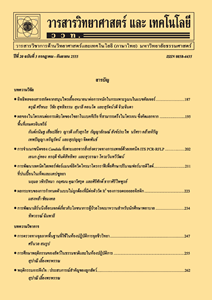ผลของการกำจัดหมู่แอซิติลของกลูโคแมนแนนจากหัวบุกต่อลักษณะเฉพาะของเจลซูริมิปลาทรายแดง
Main Article Content
Abstract
The objective of this research was to investigate the effects of deacetylation of konjac glucomannan (KGM) on gel forming ability of threadfin bream (Nemipterus hexodon) surimi gels. Sodium hydroxide solutions with different concentrations (0, 0.01 and 1.0 mol/L) were used for deacetylation of KGM. Different degrees of KGM deacetylation were obtained at 0, 64.08±1.47 and 93.49±1.04 % (D2). Molecular structure of KGM was determined by FT-IR spectroscopy. The result showed that FT-IR spectra of D2 sample was completely disappeared at 1,730 cm-1, which assigned to the group of C=O of acetyl groups. In addition, D2 sample had the lowest solubility and whiteness. Then, different degrees of KGM deacetylation were added to the threadfin bream surimi for comparison with a control (without KGM). It was found that surimi gel with D2 had the highest gel strength, and the lowest expressible water. The microstructure of surimi appeared that the addition of D2 resulted in more compact and uniform microstructures with smaller voids, comparing with the others. SDS-PAGE of surimi with different degrees of deacetylation showed no changes in protein subunit structure from its control gel.
Article Details
References
[2] Marine Fisheries Research Department, 1987, Handbook on Processing of Frozen Surimi and Fish Jelly Products in Southeast Asia, Southeast Asian Fisheries Development Center, Singapore.
[3] Park, J.W., 1994, Functional protein additives in surimi gels, J. Food Sci. 59: 525-527.
[4] Zhang, T., Xue, Y., Li, Z., Wang, Y., and Xue, C., 2015, Effects of deacetylation of konjac glucomannan on Alaska Pollock surimi gels subjected to high-temperature (120 ºC) treatment, Food Hydrocoll. 43: 125-131.
[5] Kato, K., and Matsuda, K., 1969, Studies on the chemical structure of konjac mannan, Agric. Biol. Chem. 33: 1446-1453.
[6] Du, X., Li, J., Chen, J., and Li, B., 2012, Effect of degree of deacetylation on physicochemical and gelation properties of konjac glucomannan, Food Res. Int. 46: 270-278.
[7] Chen, Z. G., Zong, M. H., and Li, G. J., 2006, Lipase-catalyzed acylation of konjac glucomannan in organic media, Process. Biochem. 41: 1514-1520.
[8] Chen, J., Li, J., and Li, B., 2011, Identifica tion of molecular driving forces involved in the gelation of konjac glucomannan: Effect of degree of deacetylation on hydrophobic association, Carbohydr. Polym. 86: 865-871.
[9] Sutloet, P. and Sompongse, W., 2014, Use of Edible Seaweed Extracts from Solieria robusta in Fish Ball Gel, Thai Sci. Technol. J. 22(1): 67-78. (in Thai)
[10] Maekaji, K., 1974, The mechanism of gelation of konjac mannan, Agric. Biol. Chem. 38: 315-321.
[11] Parry, J.M., 2010, Konjac Glucomannan, pp. 204-206, in Imerson, A., Ed., Food Stabilisers, Thickeners and Gelling Agents, John Wiley & Sons, New York.
[12] Gao, S. and Nishinari. K., 2004, Effect of degree of acetylation on gelation of konjac glucomannan, Biomacromolecules 5: 175-185.
[13] Solo-de-Zaldivar, B., Herranz, B. and Borderias, A.J., 2012, First steps in using glucomannan to make thermostable gels for potential use in mince fish restructuration, Int. J. Food Eng. 8: 1556-3758.
[14] Williams, M.A., Foster, T.J., Martin, D.R., Norton, I.T., Yoshimura, M. and Nishinari, K., 2000, A molecular description of the gelation mechanism of konjac mannan, Biomacromolecules 1: 440-500.


